Discover 50 hidden attractions, cool sights, and unusual things to do in Malta. Don't miss out on these must-see attractions: Saint John's Co-Cathedral (Valletta), Grandmaster's Palace (Valletta) or Auberge de Castille (Valletta).
Below, you can find the list of the most amazing places you should visit in Malta.
Table of Contents
Saint John's Co-Cathedral, Valletta
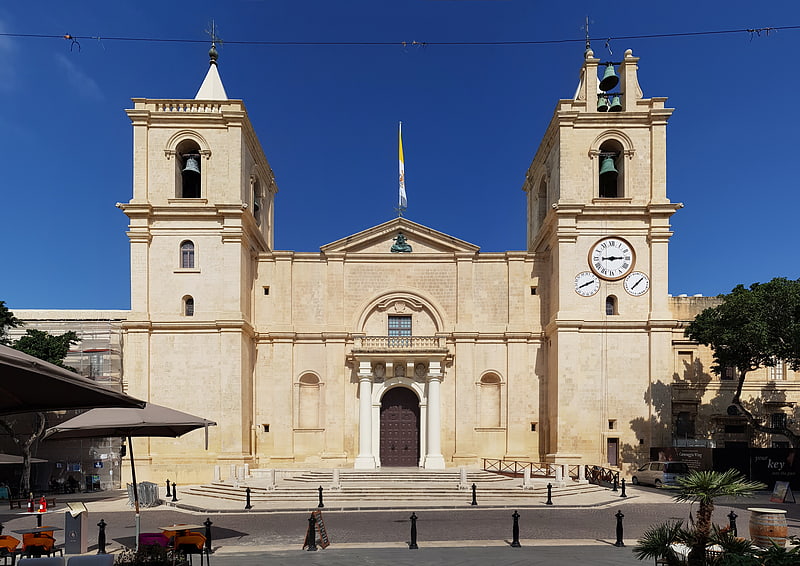
Also known as: Kon-Katidral ta' San Ġwann
16th-century high baroque cathedral. St John's Co-Cathedral is a Roman Catholic co-cathedral in Valletta, Malta, dedicated to Saint John the Baptist. It was built by the Order of St. John between 1572 and 1577, having been commissioned by Grand Master Jean de la Cassière as the Conventual Church of Saint John.
The church was designed by the Maltese architect Girolamo Cassar, who designed several of the more prominent buildings in Valletta. In the 17th century, its interior was redecorated in the Baroque style by Mattia Preti and other artists. The interior of the church is considered to be one of the finest examples of high Baroque architecture in Europe.[1]
Address: Triq San Gwann, Valletta
Grandmaster's Palace, Valletta
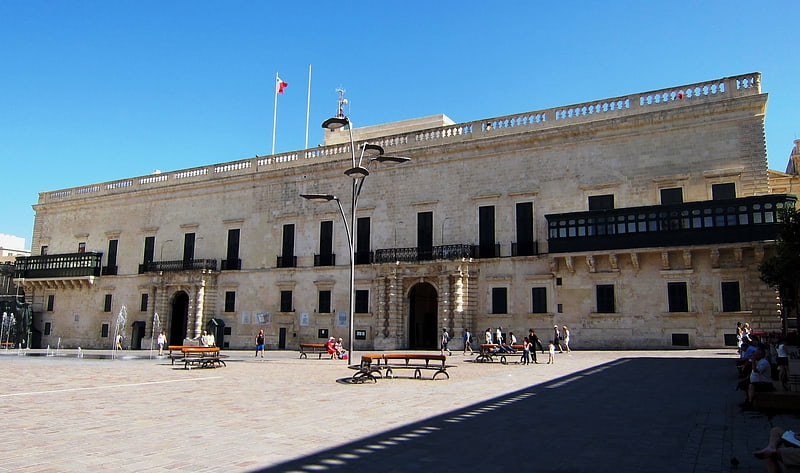
Also known as: Palazz tal-Gran Mastru
Palace in Valletta, Malta. The Grandmaster's Palace, officially known as The Palace, is a palace in Valletta, Malta. It was built between the 16th and 18th centuries as the palace of the Grand Master of the Order of St. John, who ruled Malta, and was also known as the Magisterial Palace. It eventually became the Governor's Palace, and it currently houses the Office of the President of Malta. Parts of the building, namely the Palace State Rooms and the Palace Armoury are open to the public as a museum run by Heritage Malta. The building is currently undergoing a major restoration project with only part of the armoury accessible to the public via the entrance on Merchant's Street.[2]
Address: Republic Street, VLT 1191 Valletta
Auberge de Castille, Valletta
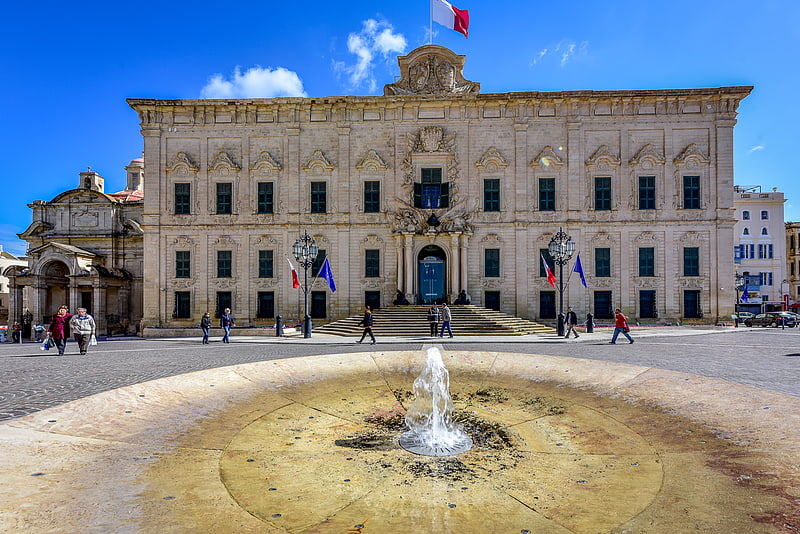
Building in Valletta, Malta. The Auberge de Castille is an auberge in Valletta, Malta. The auberge is located at Castile Place, close to Saint James Cavalier, the Malta Stock Exchange, and the Upper Barrakka Gardens. It sits at the highest point of Valletta and overlooks Floriana and the Grand Harbour area.
Built in the Baroque style under the magistracy of Manuel Pinto da Fonseca in the 1740s, it replaced a 1574 building erected to house knights of the Order of Saint John from the langue of Castile, León and Portugal.[3]
Address: Triq Il-Merkanti, Valletta
Popeye Village, Mellieħa
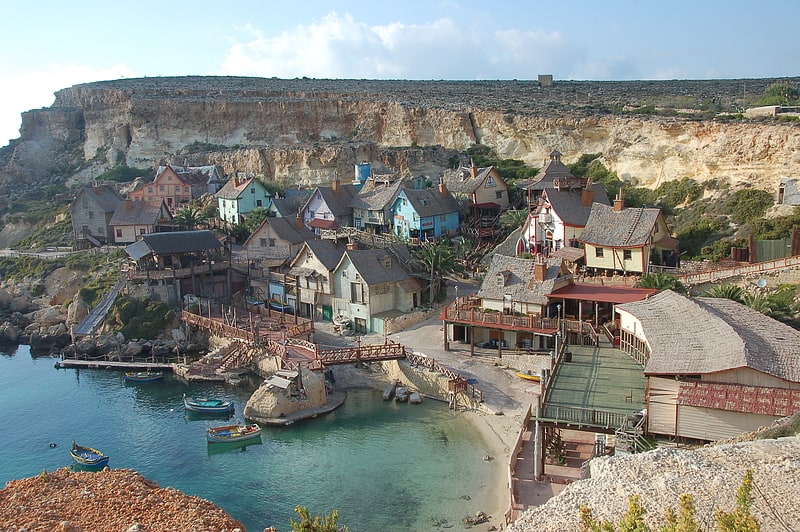
Theme park and former 'Popeye' film set. Popeye Village, also known as Sweethaven Village, is a purpose-built film set village that has been converted into a small attraction fun park, consisting of a collection of rustic and ramshackle wooden buildings. It is located at Prajjet Bay/Anchor Bay, 3 km from the village core of Mellieħa, Malta.
It was built as a film set for the production of the 1980 live-action musical feature film Popeye, produced by Paramount Pictures and Walt Disney Productions starring Robin Williams and Shelley Duvall. It is open to the public as an open-air museum and seaside resort.[4]
Address: Triq Tal-Prajjet, Mellieħa
Ħaġar Qim, Qrendi
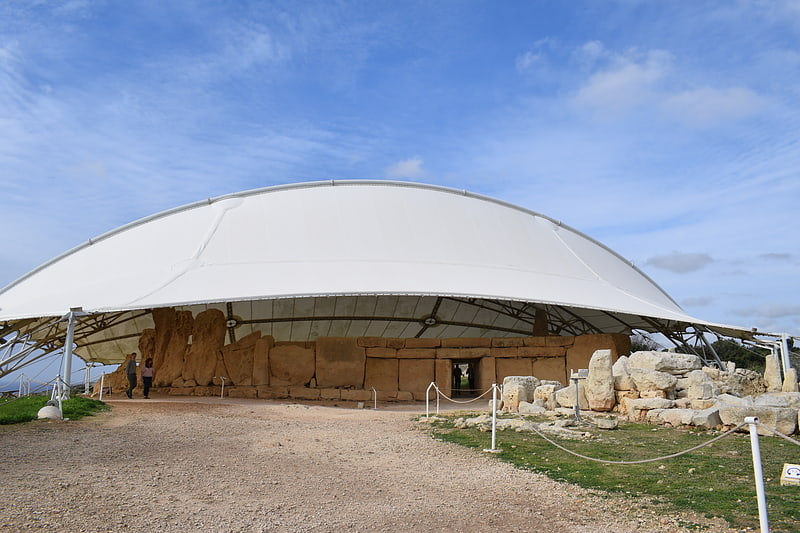
Ancient temple ruins dating from 3200 BC. Ħaġar Qim is a megalithic temple complex found on the Mediterranean island of Malta, dating from the Ġgantija phase. The Megalithic Temples of Malta are among the most ancient religious sites on Earth, described by the World Heritage Sites committee as "unique architectural masterpieces." In 1992 UNESCO recognized Ħaġar Qim and four other Maltese megalithic structures as World Heritage Sites. V. Gordon Childe, Professor of Prehistoric European Archeology and director of the Institute of Archaeology in the University of London from 1946-1957 visited Ħaġar Qim. He wrote, "I have been visiting the prehistoric ruins all round the Mediterranean, from Mesopotamia to Egypt, Greece and Switzerland, but I have nowhere seen a place as old as this one."
Ħaġar Qim's builders used globigerina limestone in the temple's construction. As a result of this, the temple has suffered from severe weathering and surface flaking over the millennia. In 2009 work was completed on a protective tent.[5]
Address: Triq Hagar Qim, QRD 2501 Il-Qrendi
Mnajdra, Qrendi
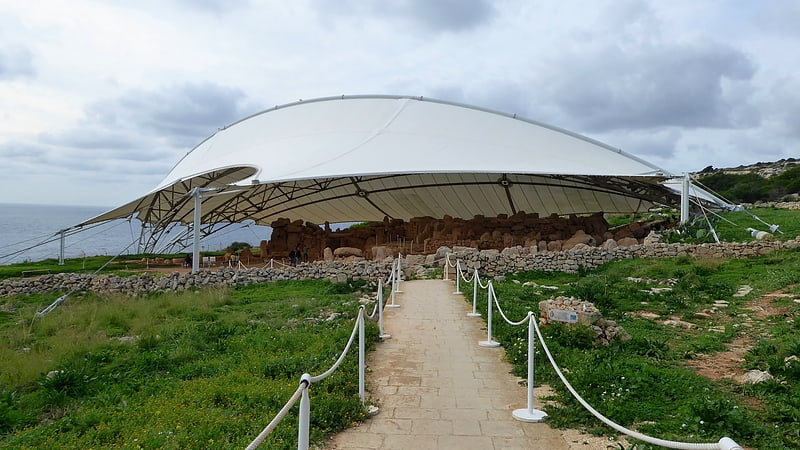
Megalithic limestone temple complex. Mnajdra is a megalithic temple complex found on the southern coast of the Mediterranean island of Malta. Mnajdra is approximately 497 metres from the Ħaġar Qim megalithic complex. Mnajdra was built around the fourth millennium BCE; the Megalithic Temples of Malta are among the most ancient religious sites on Earth, described by the World Heritage Sites committee as "unique architectural masterpieces." In 1992 UNESCO recognized the Mnajdra complex and four other Maltese megalithic structures as UNESCO World Heritage Sites. In 2009 work was completed on a protective tent.[6]
Selmun Palace, Mellieħa
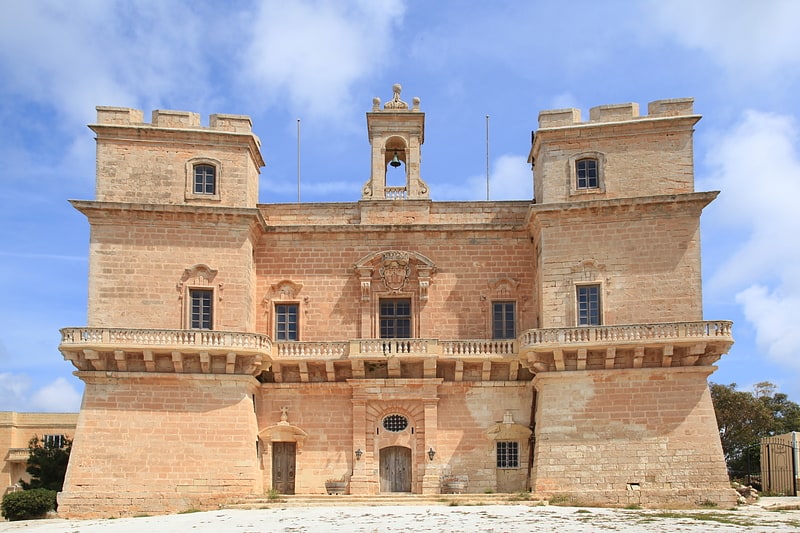
Historical landmark in Mellieħa, Malta. Selmun Palace, also known as Selmun Tower, is a villa on the Selmun Peninsula in Mellieħa, Malta. It was built in the 18th century by the Monte della Redenzione degli Schiavi, funded by the Monte di Pietà. The palace was located on the grounds of a hotel until it closed in 2011.[7]
Dragonara Casino, St. Julian's

Palace in St. Julian's, Malta. Dragonara Palace, also known as Palazzo Dragonara or Villa Dragonara, is a palace in St. Julian's, Malta. It was built in 1870 as a summer residence for the Scicluna family, and it is now a casino called Dragonara Casino.[8]
Address: Dragonara Road, STJ 3143 Saint Julian's
Spinola Bay, St. Julian's
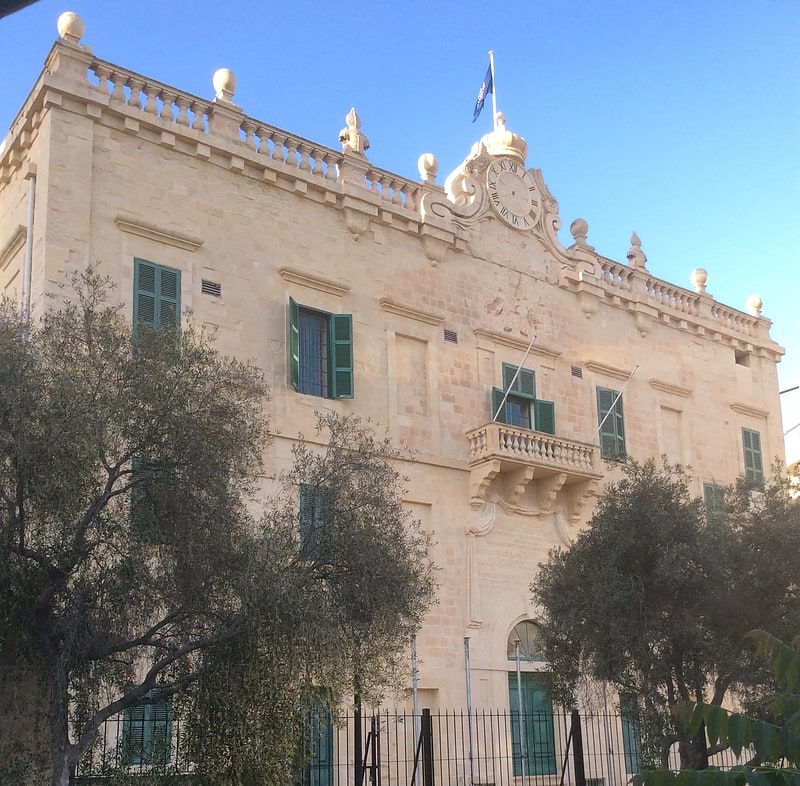
Palace in St. Julian's, Malta. Spinola Palace, also known as Spinola House and Villa Spinola, is a palace in St. Julian's, Malta. It was built in the 17th century by Fra Paolo Rafel Spinola, a knight of the Order of St. John, and was enlarged in the 18th century. The later construction was designed by Romano Carapecchia, which is considered a masterpiece, with its back having an elegant clock that is a unique feature to secular Baroque architecture in Malta.
The palace was adaptively converted to a military hospital, serving between 1860 and 1922, and was known as the Forrest Hospital. It later served for a number of purposes, including a post-World War II shelter for the homeless, a short-lived Museum of Modern Art and the Ministry for Tourism. From late 2007 till present the building actively hosts the Headquarters of the Parliamentary Assembly of the Mediterranean (PAM).
At the time of its construction a number of ancillary buildings were also built. These consisting of a church, two boathouses, a belvedere and a building serving as stables. They still survive today belonging to different private owners, with the palace belonging to the Maltese government. Originally the building had large extensive gardens, including baroque gardens and wineyards, however these were minimized to an enclosed back garden and a small front public garden.[9]
Address: Triq San Ġorġ, St. Julian's
Saint Agatha's Tower, Mellieħa

17th-century fortress with island views. Saint Agatha's Tower, also known as the Red Tower, Mellieħa Tower or Fort Saint Agatha, is a large bastioned watchtower in Mellieħa, Malta. It was built between 1647 and 1649, as the sixth of the Lascaris towers. The tower's design is completely different from the rest of the Lascaris towers, but it is similar to the earlier Wignacourt towers. St. Agatha's Tower was the last large bastioned tower to be built in Malta.[10]
Address: Triq Tad-Dahar, Mellieħa
Ġgantija, Xaghra
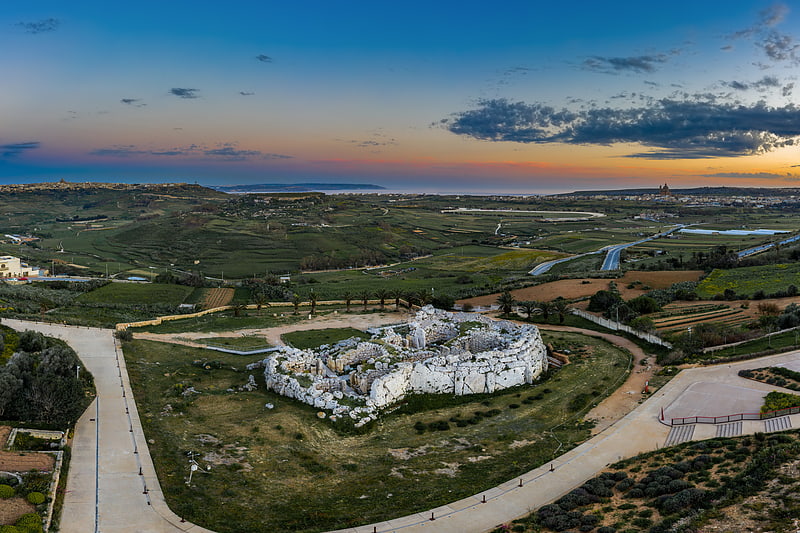
Archaeological site in Xagħra, Malta. Ġgantija is a megalithic temple complex from the Neolithic on the Mediterranean island of Gozo in Malta. The Ġgantija temples are the earliest of the Megalithic Temples of Malta and are older than the pyramids of Egypt. Their makers erected the two Ġgantija temples during the Neolithic, which makes these temples more than 5500 years old and the world's second oldest existing manmade religious structures after Göbekli Tepe in present-day Turkey. Together with other similar structures, these have been designated a UNESCO World Heritage Site, the Megalithic Temples of Malta.
The temples are elements of a ceremonial site in a fertility rite. Researchers have found that the numerous figurines and statues found on site are associated with that cult. According to local Gozitan folklore, a giantess who ate nothing but broad beans and honey bore a child from a man of the common people. With the child hanging from her shoulder, she built these temples and used them as places of worship.[11]
Address: Triq John Otto Bayer, Xaghra
Fort Tigné, Sliema
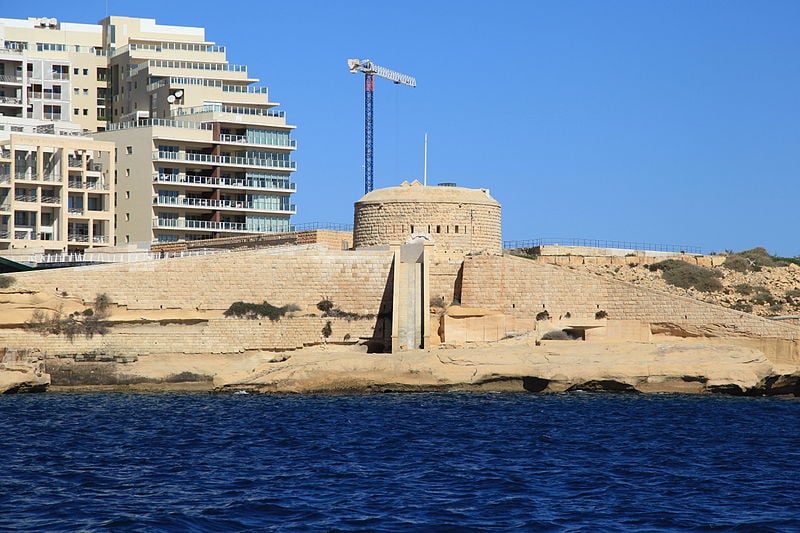
Historical landmark in Sliema, Malta. Fort Tigné is a polygonal fort in Tigné Point, Sliema, Malta. It was built by the Order of Saint John between 1793 and 1795 to protect the entrance to Marsamxett Harbour, and it is one of the oldest polygonal forts in the world. The fort was extensively altered by the British in the 19th century, and it remained in use by the military until 1979.
Fort Tigné was restored in the early 21st century, and it is now in good condition. It has been on Malta's tentative list of UNESCO World Heritage Sites since 1998, as part of the Knights' Fortifications around the Harbours of Malta.[12]
Palazzo Falson, Rabat
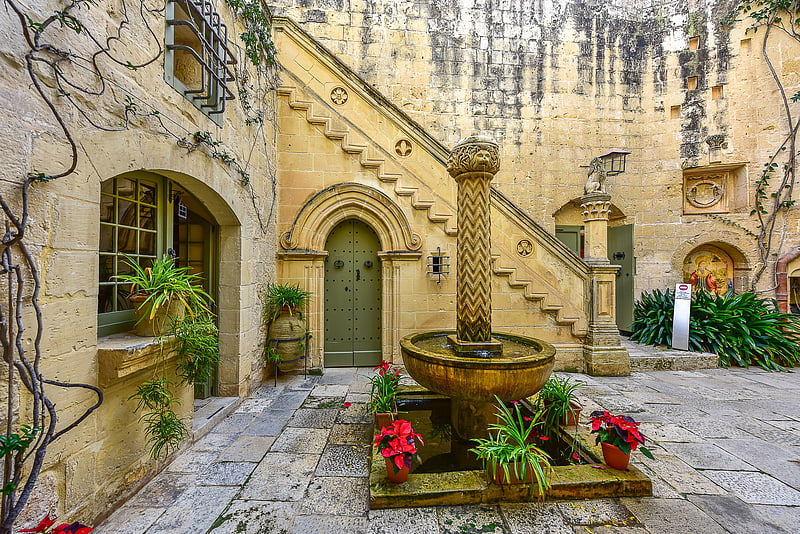
Museum in Mdina, Malta. Palazzo Falson, formerly known as Palazzo Cumbo-Navarra, Casa dei Castelletti, and the Norman House, is a medieval townhouse in Mdina, Malta. It was purposely built as a family residence by the Maltese nobility, and it is named after the Falson family. It is presently open to the public as a house-museum with seventeen rooms of historic domestic belongings and a number of antique collections.
The building is believed to have been built in around 1495, probably incorporating parts of a 13th-century building. This makes it the second oldest building in Mdina, after the ground floor of Palazzo Santa Sofia. During the rule of the Order of St. John, the building might have received Philippe Villiers de L'Isle-Adam, the first Grand Master in Malta. The building was further enlarged in the mid-16th century. Its architect is unknown, but the distinctive upper floor windows might be the work of Jacobo Dimeg.
Palazzo Falson was acquired by Olof Frederick Gollcher in the 20th century, and he restored and altered parts of the building. It is now owned by a foundation established by Gollcher, and since 2007 it has been open to the public as the Palazzo Falson Historic House Museum, which is managed by the Fondazzjoni Patrimonju Malti, a Maltese heritage foundation. It displays permanent collections which originally belonged to Gollcher, and occasionally other temporary exhibits from private collections.
The building was included on the Antiquities List of 1925, it has been a Grade 1 scheduled property since 1992, and is on the list of the National Inventory of the Cultural Property of the Maltese Islands.[13]
St. George's Basilica, Victoria

Collegiate church in Victoria, Malta. St. George's Basilica or the Basilica and Collegiate Parish Church of Saint George, also simply known as San Ġorġ in Maltese, is a historic Baroque church situated in the middle of Gozo, the second largest island in the Maltese archipelago, and is surrounded by a maze of old narrow streets and alleys. Today's basilica was built between 1672 and 1678.
This is not to be confused with another church by the same name, located in Qormi on the main island, Malta.[14]
Address: Charity Street, 1200 Victoria
Portomaso Marina - Malta, St. Julian's
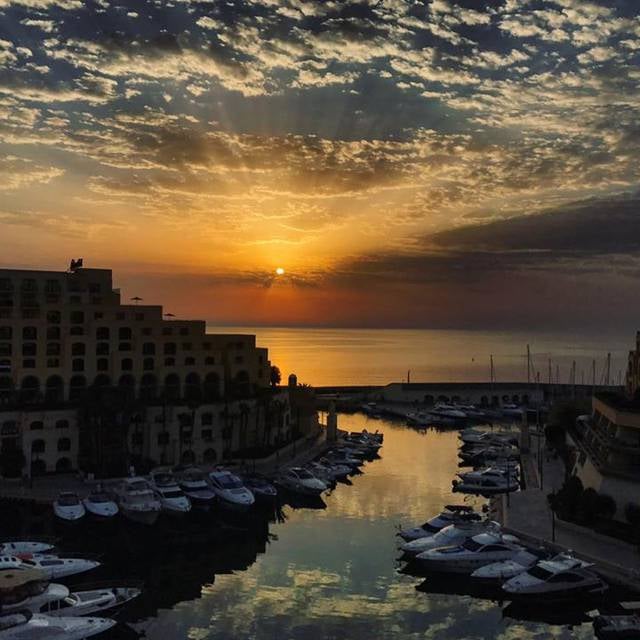
Sailing, Park, Marina
Rotunda of Mosta, Mosta

Neoclassical church with a famous dome. The Sanctuary Basilica of the Assumption of Our Lady, commonly known as the Rotunda of Mosta or the Mosta Dome, is a Roman Catholic parish church and Minor Basilica in Mosta, Malta, dedicated to the Assumption of Mary. It was built between 1833 and the 1860s to neoclassical designs of Giorgio Grognet de Vassé, on the site of an earlier Renaissance church which had been built in around 1614 to designs of Tommaso Dingli.
The design of the present church is based on the Pantheon in Rome, has the third largest unsupported dome in the world and is Malta's largest and most famous church. The church narrowly avoided destruction during World War II when on 9 April 1942 a German aerial bomb pierced the dome and fell into the church during Mass, but failed to explode. This event was interpreted by the Maltese as a miracle.[15]
Address: Rotunda Square, Mosta
Fort Manoel, Sliema

18th-century star fort on the water. Fort Manoel is a star fort on Manoel Island in Gżira, Malta. It was built in the 18th century by the Order of Saint John, during the reign of Grand Master António Manoel de Vilhena, after whom it is named. Fort Manoel is located to the north west of Valletta, and commands Marsamxett Harbour and the anchorage of Sliema Creek. The fort is an example of Baroque architecture, and it was designed with both functionality and aesthetics in mind.
After a brief French occupation which began in 1798, the British military took over the fort in 1800, when it became known as HMS Phoenicia, and it remained in use by them until 1964. The fort was severely damaged in World War II, but it was restored in the early 21st century and it is now in good condition.
Fort Manoel has been on Malta's tentative list of UNESCO World Heritage Sites since 1998, as part of the Knights' Fortifications around the Harbours of Malta.[16]
Cittadella, Victoria

Fortress in Victoria, Malta. The Cittadella, also known as the Castello, is the citadel of Victoria on the island of Gozo, Malta. The area has been inhabited since the Bronze Age, and the site now occupied by the Cittadella is believed to have been the acropolis of the Punic-Roman city of Gaulos or Glauconis Civitas.
During the medieval period, the acropolis was converted into a castle which served as a refuge for Gozo's population. A suburb began to develop outside its walls by the 15th century, and this area now forms the historic core of Victoria. The castle's defences were obsolete by the 16th century, and in 1551 an Ottoman force invaded Gozo and sacked the Cittadella.
A major reconstruction of the southern walls of the Cittadella was undertaken between 1599 and 1622, transforming it into a gunpowder fortress. The northern walls were left intact, and today they still retain a largely medieval form. The new fortifications were criticized in later decades, and plans to demolish the entire citadel were made multiple times in the 17th and 18th centuries, but were never carried out.
The Cittadella briefly saw action during the French invasion and subsequent uprising in 1798; in both cases the fortress surrendered without much of a fight. It remained a military installation until it was decommissioned by the British on 1 April 1868.
The Cittadella contains churches and other historic buildings, including the Cathedral of the Assumption, which was built between 1697 and 1711 on the site of an earlier church. The citadel has been included on Malta's tentative list of UNESCO World Heritage Sites since 1998.[17]
Gozo Museum of Archaeology, Victoria
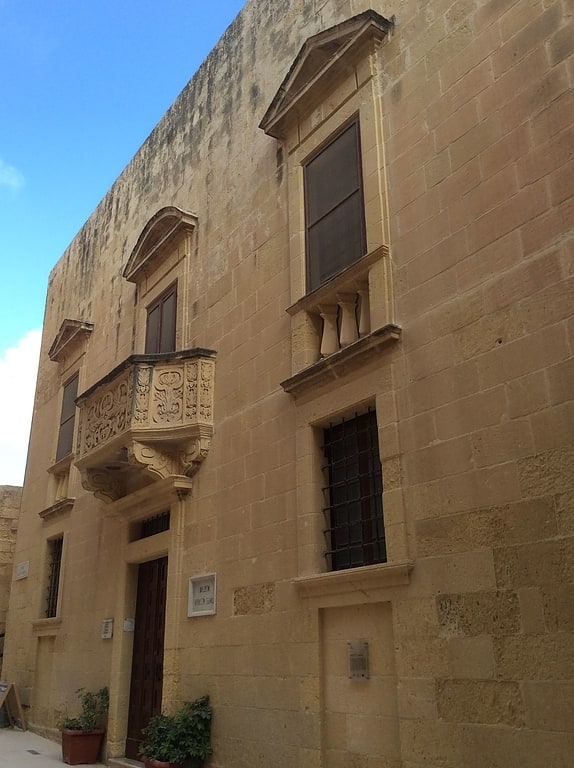
Museum in Victoria, Malta. The Gozo Museum of Archaeology is a museum in the Cittadella of Victoria in Gozo, Malta. The museum of was opened in 1960 as the first public museum in Gozo and was known as the Gozo Museum. The museum was redesigned and reopened in 1986 as the Archaeology Museum of Gozo. Today it is known as the Gozo Museum of Archaeology or the National Museum of Archaeology. The museum features archaeological artifacts and relics and displays covering the cultural history of the Island of Gozo from the prehistoric era to the early modern period. Its exhibits include the Maymūnah Stone.
The museum is housed in a 17th-century house which was originally known as Casa Bondi. It was sold to the Government by the Bondi family in 1937. It is a two-storey building with a symmetrical austere façade, with a carved stone balcony above the front door. The building is listed on the National Inventory of the Cultural Property of the Maltese Islands.[18]
Address: Triq Bieb l-Imdina, Victoria
Verdala Palace, Malta Island
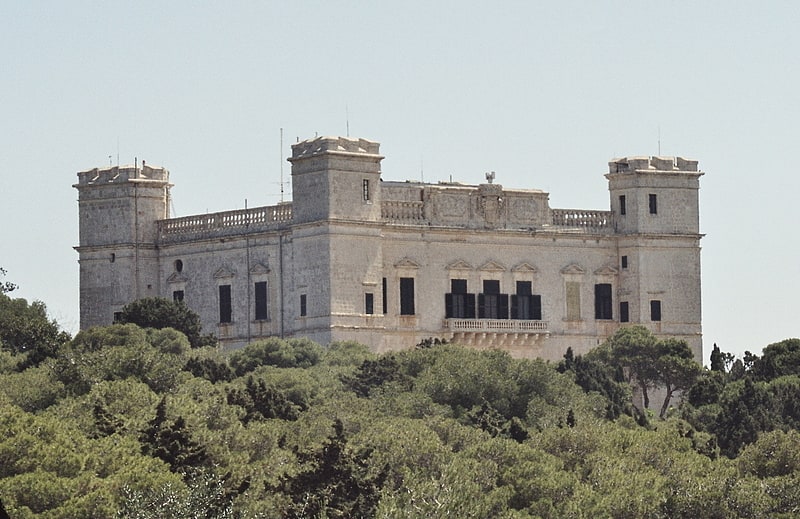
Palace in Siġġiewi, Malta. Verdala Palace is a palace in the Buskett Gardens, limits of Siġġiewi, Malta. It was built in 1586 during the reign of Hugues Loubenx de Verdalle, and it now serves as the official summer residence of the President of Malta.[19]
St. Paul's Cathedral, Rabat
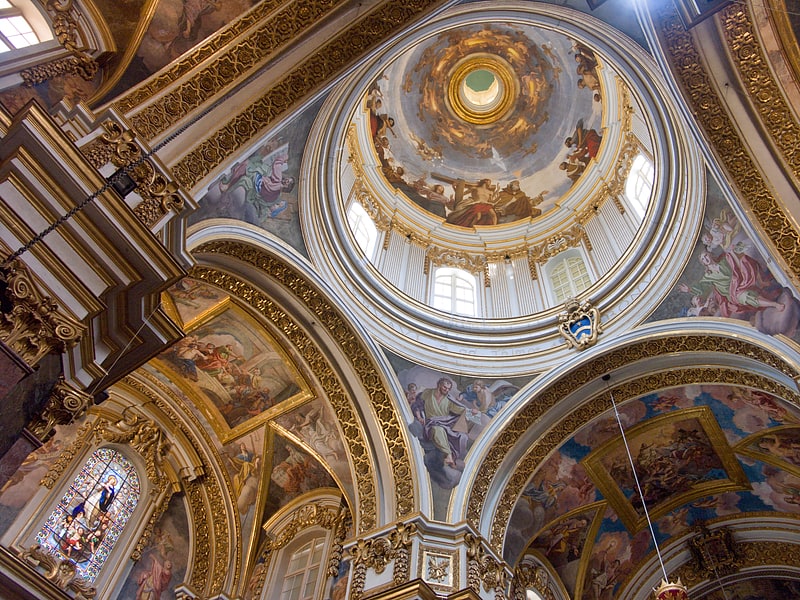
Baroque Catholic church with paintings. The Metropolitan Cathedral of Saint Paul, commonly known as St Paul's Cathedral or the Mdina Cathedral, is a Roman Catholic cathedral in Mdina, Malta, dedicated to St. Paul the Apostle. The cathedral was founded in the 12th century, and according to tradition it stands on the site of where Roman governor Publius met St. Paul following his shipwreck on Malta. The original cathedral was severely damaged in the 1693 Sicily earthquake, so it was dismantled and rebuilt in the Baroque style to a design of the Maltese architect Lorenzo Gafà between 1696 and 1705. The cathedral is regarded as Gafà's masterpiece.
The cathedral is the seat of the Roman Catholic Archdiocese of Malta, and since the 19th century this function has been shared with St. John's Co-Cathedral in Valletta.[20]
Address: 2 Triq San Pawl, MDN 1061 L-Imdina
Orpheum Theatre, Sliema

The Orpheum Theatre is a building situated in Gżira, Malta. It was designed in 1932 by the Maltese architect Harold J. Borg, then still in his early twenties, to the design of Art Nouveau with Spanish features.
The theatre was commissioned by Felix Gerada, a developer who lived between Malta and Detroit (hence the initials FG on the façade) on land he purchased from the Marquis Desain and was built to serve as a movie theatre. The carved relief is said to be the work of sculptor Alfredo Azzopardi, who had already worked on the Balluta buildings as well as on the Msida Parish church. The Orpheum is a Grade 1 scheduled building since 2001 thanks to the presence of a painting of Orpheus on the ceiling, by Raphael Bonnici Calì (1907-2002).
The Orpheum is a near-complete survivor of the large, single-screen cinemas on Malta. Like many of the island’s cinemas, it was flat-floored in the stalls and had a single balcony.[21]
Playmobil Funpark, Żurrieq
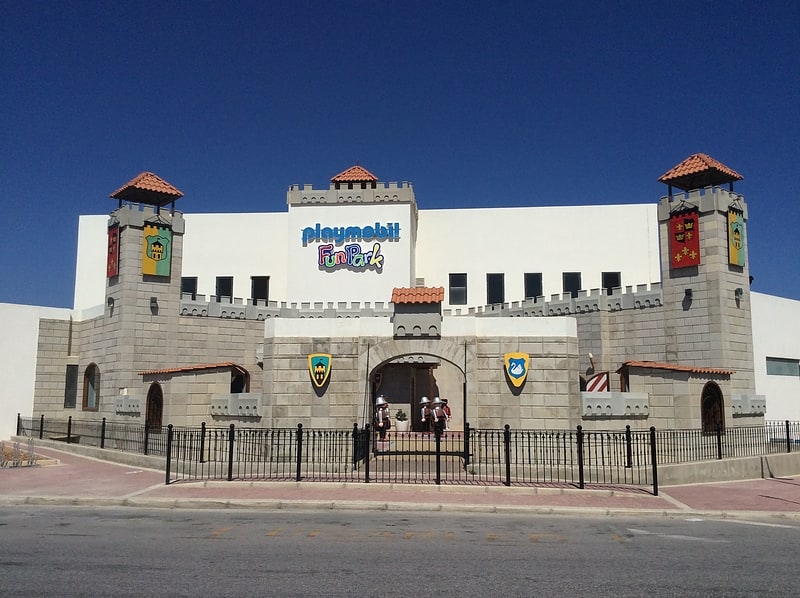
Playmobil FunPark is the world's second largest Playmobil factory, located in Ħal Far in the extreme south of Malta. Although smaller than the Playmobil FunPark headquarters in Zirndorf, some 2 million Playmobils a week are made at the factory which also offers a 45-minute tour of the factory and facilities for children.[22]
Address: HF 80, Industrial Estate, BBG06 Hal Far
Fort San Lucian, Marsaxlokk
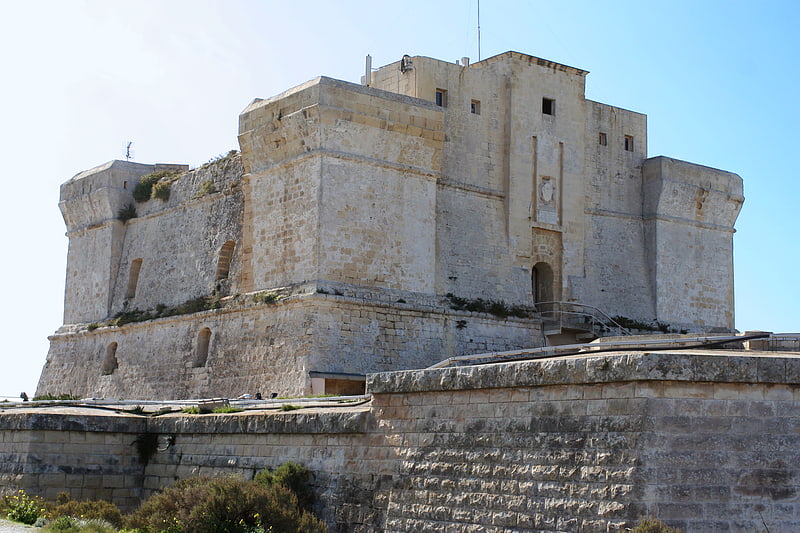
Historical place in Birżebbuġa, Malta. Fort San Lucian, also known as Saint Lucian Tower or Fort Rohan, is a large bastioned watchtower and polygonal fort in Marsaxlokk, Malta. The original tower was built by the Order of Saint John between 1610 and 1611, being the second of six Wignacourt towers.
An artillery battery was added in around 1715, and the complex was upgraded into a fort in the 1790s. In the 1870s, the fort was rebuilt by the British in the polygonal style. Saint Lucian Tower is the second largest watchtower in Malta, after Saint Thomas Tower. Today, the tower and fort are used by the Malta Aquaculture Research Centre.[23]
Domus Romana, Rabat

Museum in Mdina, Malta. The Domus Romana, stylized as the Domvs Romana, is a ruined Roman-era house located on the boundary between Mdina and Rabat, Malta. It was built in the 1st century BC as an aristocratic town house within the Roman city of Melite. In the 11th century, a Muslim cemetery was established on the remains of the domus.
The site was discovered in 1881, and archaeological excavations revealed several well preserved Roman mosaics, statues and other artifacts, as well as a number of tombstones and other remains from the cemetery. Since 1882, the site has been open to the public as a museum, which is currently run by Heritage Malta. It was erroneously called the Roman Villa when rediscovered as it was thought to be outside the city of Melite but on further examinations it was clarified to be within city limits.[24]
Address: Museum Esplanade, RBT 05 Rabat
Charles Abela Memorial Stadium, Mosta

Stadium in Mosta, Malta. The Charles Abela Memorial Stadium, also known as the Mosta Ground is a ground situated in Mosta, Malta. It has a total capacity of 700 with 360 seats. The stadium hosts matches from various competitions, most notably the Maltese Third Division and the Women Maltese First Division.[25]
Tarxien Temples, Fgura

Megalithic temples dating from 3600 B.C.. The Tarxien Temples are an archaeological complex in Tarxien, Malta. They date to approximately 3150 BC. The site was accepted as a UNESCO World Heritage Site in 1992 along with the other Megalithic temples on the island of Malta.[26]
Address: Triq It Tempji Neolitici, TXN 1063 Ħal Tarxien
Malta Aviation Museum, Malta Island
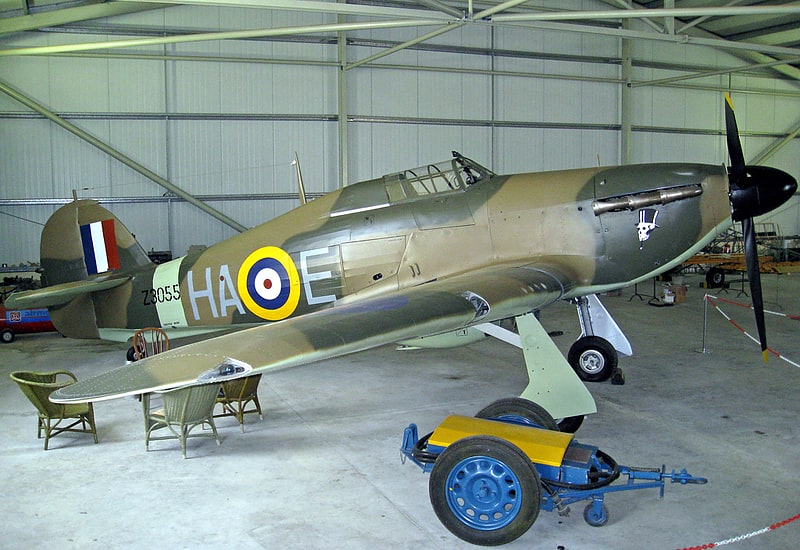
Museum in Attard, Malta. Malta Aviation Museum is an aircraft museum situated on the site of the former Royal Air Force airfield in the village of Ta'Qali, on the island of Malta. The museum, based in three hangars, covers the history of aviation on the island with exhibits, particularly from the Second World War and post-war periods. The museum is involved in the preservation and restoration of aircraft, some of which are in airworthy condition. In 2021, a new Main Exhibition Hangar was funded by the EU.[27]
Address: Ta' Qali Crafts Village, 4000 Ta' Qali
Girgenti Palace, Malta Island
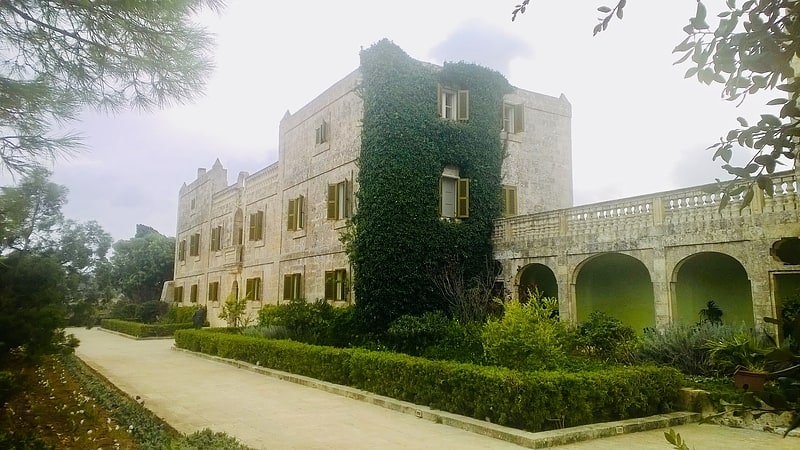
Museum in Siġġiewi, Malta. Girgenti Palace is a palace near Siġġiewi, Malta. It was built in 1625 as the summer residence of Malta's inquisitor, and is therefore also known as the Inquisitor's Palace. It is now an official residence of the Prime Minister of Malta.[28]
Fort San Lucian, Marsaxlokk

Historical place in Birżebbuġa, Malta. Fort San Lucian, also known as Saint Lucian Tower or Fort Rohan, is a large bastioned watchtower and polygonal fort in Marsaxlokk, Malta. The original tower was built by the Order of Saint John between 1610 and 1611, being the second of six Wignacourt towers.
An artillery battery was added in around 1715, and the complex was upgraded into a fort in the 1790s. In the 1870s, the fort was rebuilt by the British in the polygonal style. Saint Lucian Tower is the second largest watchtower in Malta, after Saint Thomas Tower. Today, the tower and fort are used by the Malta Aquaculture Research Centre.[29]
Malta National Aquarium, Buġibba
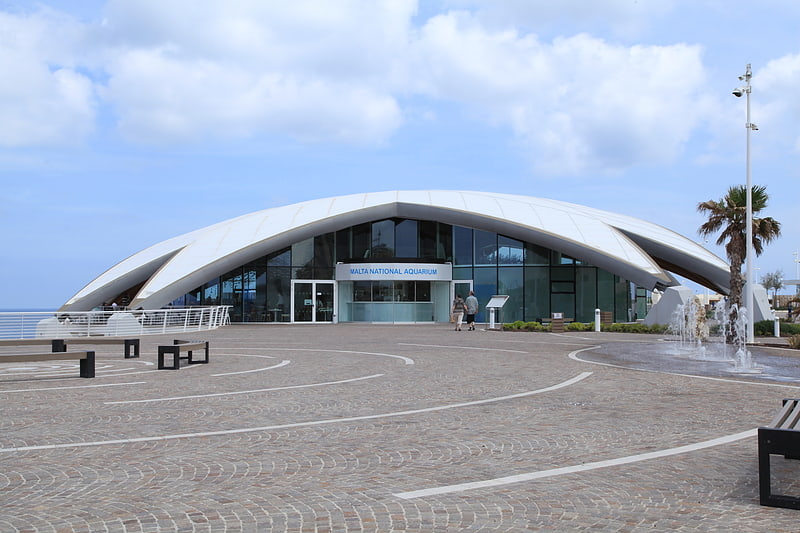
Aquarium in St. Paul's Bay, Malta. The Malta National Aquarium is the largest aquarium in the Maltese Islands.
It is located in Qawra, in the northern part of the island of Malta, and it hosts more than 175 different species of various animals, including fish, mollusca, reptiles and insects.[30]
Address: Triq It-Trunciera, SPB 1500 Qawra
Inland Sea, San Lawrenz

Lagoon in Malta. The Inland Sea, sometimes called Qawra in Maltese and also known as Dwejra, is a lagoon of seawater on the island of Gozo linked to the Mediterranean Sea through an opening formed by a narrow natural arch.
It was probably formed where a geological fault in the limestone had created a sea cave and the roof then collapsed.
On one side there is a gently shelving stony beach with several fishermen's huts. The boats are often pulled up on to the stony beach. The bottom of the lagoon is also mostly pebbles and rocks and is fairly shallow. Exiting through the tunnel towards open sea, the floor drops away in a series of shelves to a depth of up to 35 meters on the outside. Jacques Cousteau said the Inland Sea was among his top ten dives.
On calm days fishing boats, known in Maltese as luzzijiet, can pass through the tunnel. Some of the boats are used to take visitors through the archway and then for a tour of the nearby cliffs and other sites, mainly to the Fungus Rock and to the site of the previous large natural arch in the cliffs called the Azure Window.[31]
Address: Triq Wied Merill, SLZ 1323 San Lawrenz
Fort Delimara, Marsaxlokk

Tourist attraction in Marsaxlokk, Malta. Fort Delimara is a polygonal fort in Marsaxlokk, Malta. It was built between 1876 and 1888 by the British as part of a chain of fortifications intended to protect Marsaxlokk Harbour. Today, the fort is still intact but is in need of restoration, and is in danger of collapse due to coastal erosion.[32]
Xlendi Tower, Xlendi
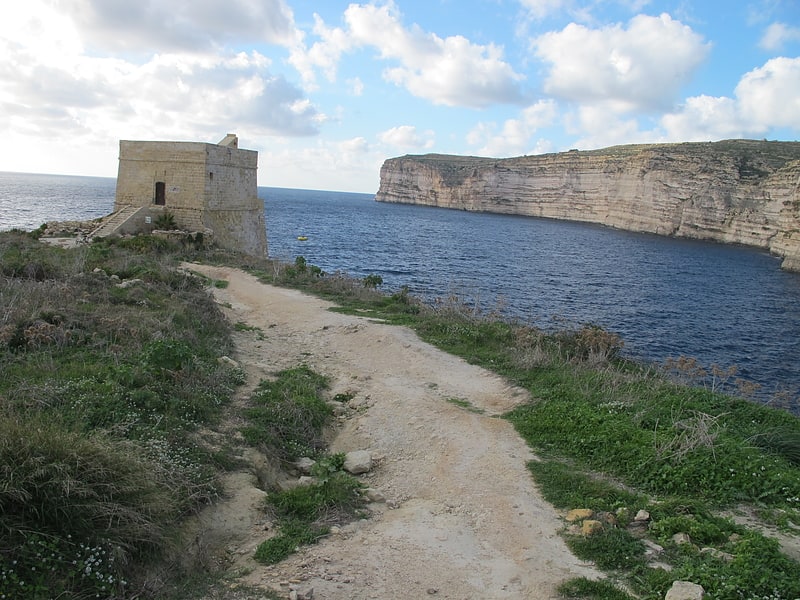
Tower in Munxar, Malta. Xlendi Tower is a small watchtower near Xlendi Bay, within the limits of Munxar on the island of Gozo in Malta. The tower is one of the Lascaris towers and dates to 1650; it is currently undergoing restoration.
It is the oldest of the four surviving watchtowers on Gozo. The earlier Garzes and Marsalforn towers were destroyed in the 18th and 19th centuries.[33]
Fort St. Angelo, Fgura
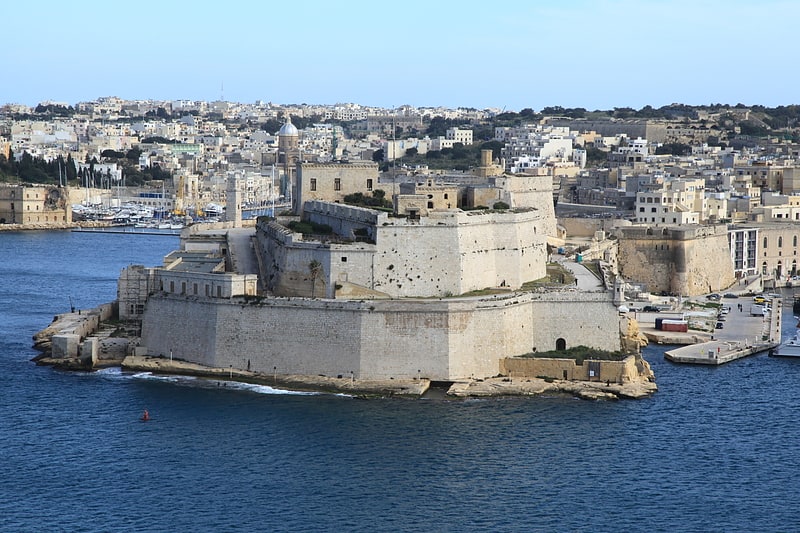
Also known as: Forti Sant’Anġlu
Storied fort with historical exhibits. Fort St. Angelo is a bastioned fort in Birgu, Malta, located at the centre of the Grand Harbour. It was originally built in the medieval period as a castle called the Castrum Maris. It was rebuilt by the Order of Saint John as a bastioned fort called Fort Saint Angelo between the 1530s and the 1560s, and it is best known for its role as the Order's headquarters during the Great Siege of Malta of 1565. A major reconstruction to designs of Carlos de Grunenbergh took place in the 1690s, giving the fort its current appearance.
The fort was garrisoned by the British from 1800 to 1979, at times being classified as a stone frigate known as HMS Egmont or later HMS St Angelo. The fort suffered considerable damage during World War II, but it was later restored. In 1998, the upper part of the fort was handed to the Sovereign Military Order of Malta. Fort St. Angelo has been on Malta's tentative list of UNESCO World Heritage Sites since 1998, as part of the Knights' Fortifications around the Harbours of Malta.[34]
Address: Birgu Waterfront, Fgura
Wignacourt Tower, St. Paul's Bay
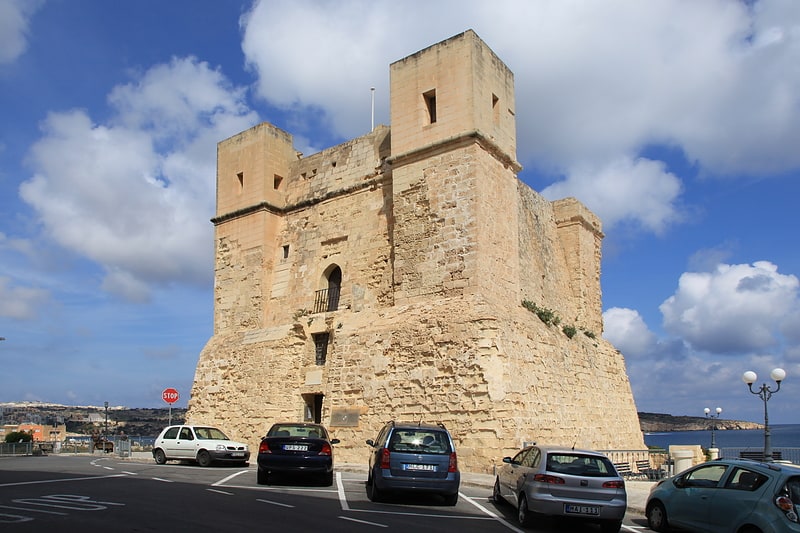
Tower in St. Paul's Bay, Malta. Wignacourt Tower, also known as Saint Paul's Bay Tower, is a bastioned watchtower in St. Paul's Bay, Malta. It was the first of six Wignacourt towers to be built, and it was completed in 1610. It replaced the role of Ta' Tabibu farmhouse which was previously known as Dejma Tower. An artillery battery was added a century later in 1715. Today the tower is a museum.
Wignacourt Tower was the second tower to be built in the Maltese islands, after Garzes Tower on Gozo. It was also the first tower to be built on the main island. As Garzes Tower was demolished in 1848, Wignacourt Tower is now the oldest surviving watchtower in Malta.[35]
Address: Triq San Franġisk, St. Paul's Bay
Ta' Ċenċ Cliffs, Xlendi
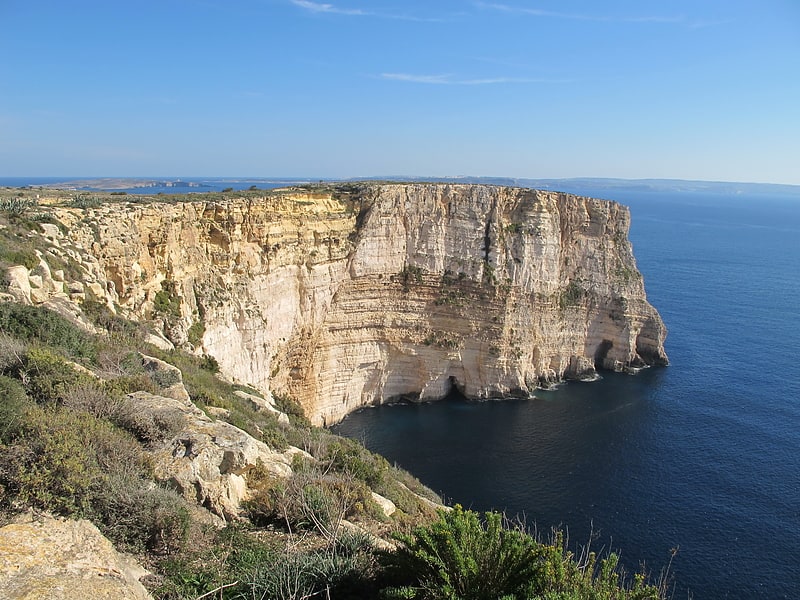
Tourist attraction in Sannat, Malta. Ta' Ċenċ Cliffs also Sanap Cliffs is a 20 ha linear strip of cliffed coastline at Sannat, on the southern coast of the island of Gozo, Malta, in the Mediterranean Sea. The area consists of garrigue and steep and rugged cliffs, which rise from sea level to a height of 120 m. The cliffs are identified as an Important Bird Area by BirdLife International because they support 800–1000 breeding pairs of Cory's shearwaters and 150–300 pairs of yelkouan shearwaters.
Archaeological remains have also been found close to the cliffs. These include Borġ l-Imramma (the remains of an Mġarr phase megalithic temple), two dolmens dating back to the Tarxien Cemetery phase and a number of cart ruts.[36]
Chapel of St Catherine, Qrendi
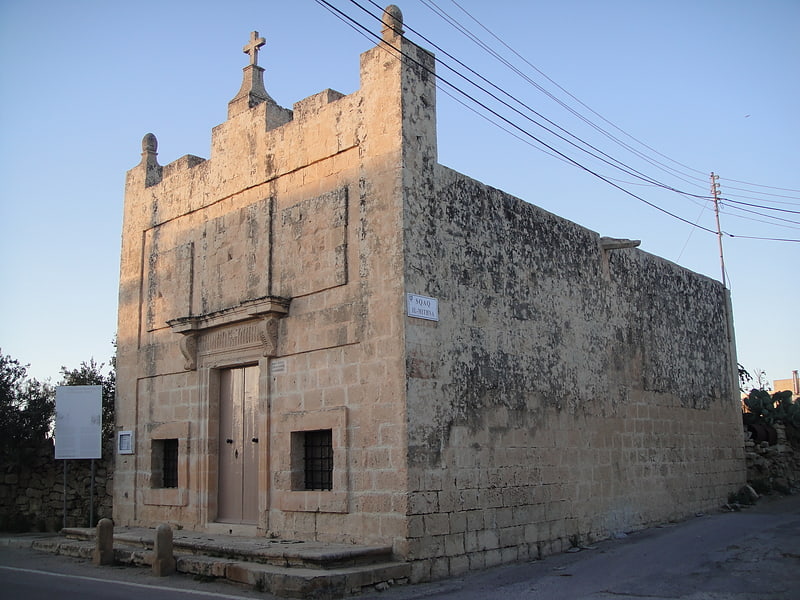
The Chapel of St Catherine is a small Roman Catholic church located in the village of Qrendi, Malta.[37]
San Anton Palace, Attard
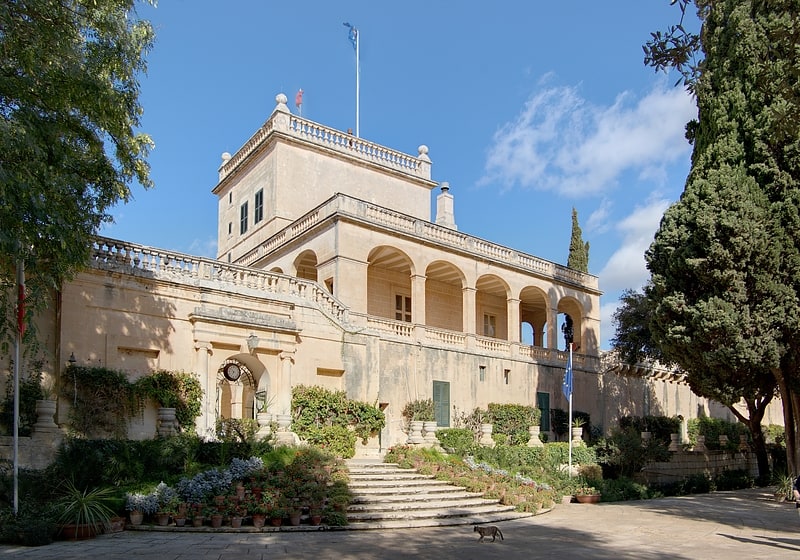
Also known as: Palazz ta' Sant'Anton
Palace in Attard, Malta. San Anton Palace is a palace in Attard, Malta that currently serves as the official residence of the President of Malta. It was originally built in the early 17th century as a country villa for Antoine de Paule, a knight of the Order of St. John. It was expanded into a palace following de Paule's election as Grand Master in 1623.
The palace was used as a residence by subsequent Grand Masters, being enlarged a number of times in the process. It was the headquarters of the rebel National Assembly during the uprising of 1798–1800, and it later became a residence for the Civil Commissioners, Governors and Governors-General of Malta. It has been the official residence of the President since the office was created in December 1974.
The palace is surrounded by the extensive San Anton Gardens, parts of which have been open to the public since 1882.[38]
Address: 7 St. George's, Attard
Malta Classic Car Museum, Buġibba

The Malta Classic Car Museum is a museum on the island state of Malta.[39]
Address: Tourists Street, SPB 1020 Qawra
Ras il-Wardija, Xlendi

Archaeological site in Saint Lawrence, Malta. Ras il-Wardija is a promontory in the limits of San Lawrenz, on the southwest coast of Gozo, Malta. It contains the remains of a Punic-Roman sanctuary, which was excavated by Italian archaeologists in the 1960s. The area is privately owned and it is currently in a dilapidated state.[40]
Our Lady of Loreto Parish Church, Għajnsielem
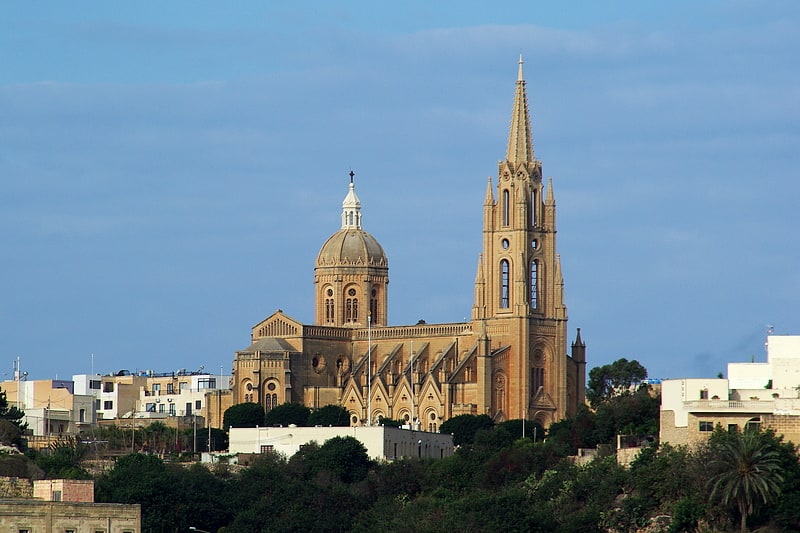
Parish church. Parish Church of Our Lady of Loreto is a Roman Catholic neo-gothic parish church located in the village of Għajnsielem on the island of Gozo, Malta.[41]
Fort Campbell, Buġibba
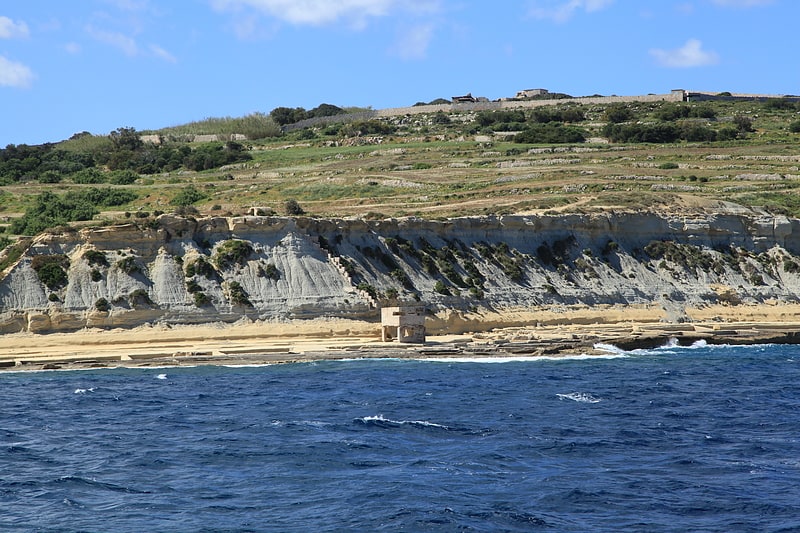
Historical landmark in Mellieħa, Malta. Fort Campbell, also known locally as Il-Fortizza ta' Selmun, is a former fort in Mellieħa, Malta. It was built by the British between 1937 and 1938. It is notable as the most important fortification north of the Victoria Lines, and the last major fortification to be built in Malta. Today, it lies in ruins.[42]
Mistra Battery, St. Paul's Bay
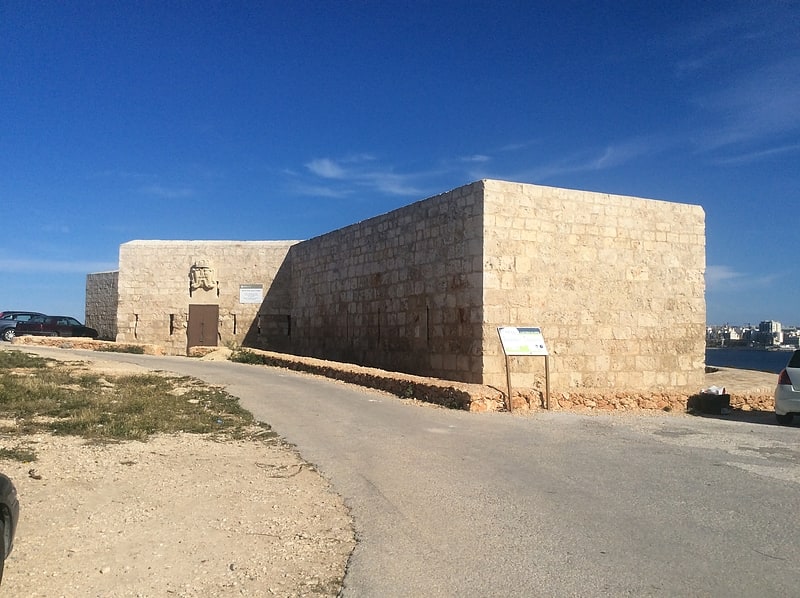
Tourist attraction in Mellieħa, Malta. Mistra Battery, formerly also known as Despirasse Battery, is an artillery battery in Mistra Bay, Mellieħa, Malta. It was built by the Order of Saint John in the 18th century as one of a series of coastal fortifications around the coasts of the Maltese Islands.
The battery is considered as the best preserved of the Order's batteries in Malta, since it retains all of its original features. Many other batteries have been destroyed or otherwise modified, and very few have survived in their original state.[43]
Għar Dalam, Cottonera
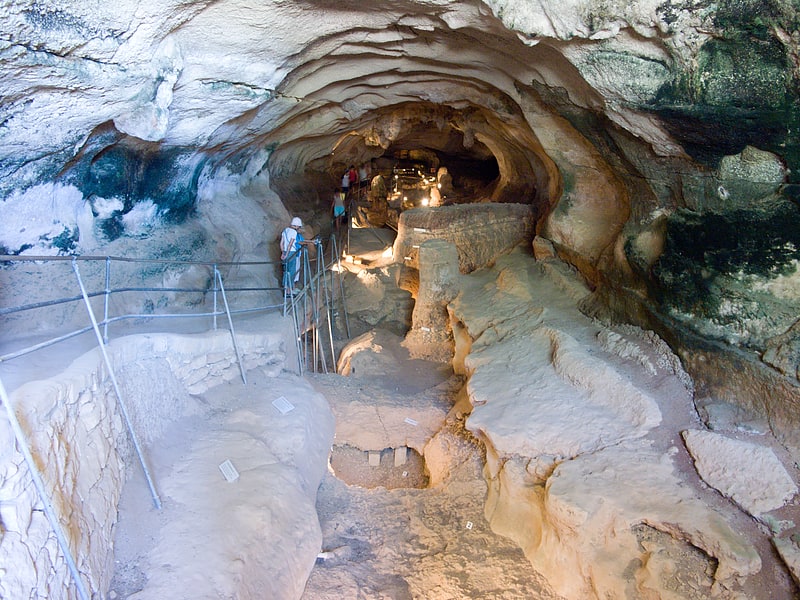
Museum in Birżebbuġa, Malta. Għar Dalam is a 144 metre long phreatic tube and cave, or cul-de-sac, located in the outskirts of Birżebbuġa, Malta. The cave contains the bone remains of animals that were stranded and subsequently became extinct in Malta at the end of the Last Glacial Maximum. It has lent its name to the Għar Dalam phase in Maltese prehistory, and is viewed as one of Malta's most important national monuments. Pottery similar to that found in Stentinello was found at Għar Dalam, but lacking details such as stamp decorations.
Dwarf elephant, hippopotamus, giant swan, deer and bear bone deposits found there are of different ages; the hippopotamuses became extinct about 10,000 years ago, whilst the deer species became extinct much later, about 4000 years ago during the Chalcolithic. It is also here that the earliest evidence of human settlement on Malta, some 7,400 years ago, was discovered.[44]
Address: Triq Ghar Dalam, BBG 9015 Birzebbuga
Malta Maritime Museum, Fgura
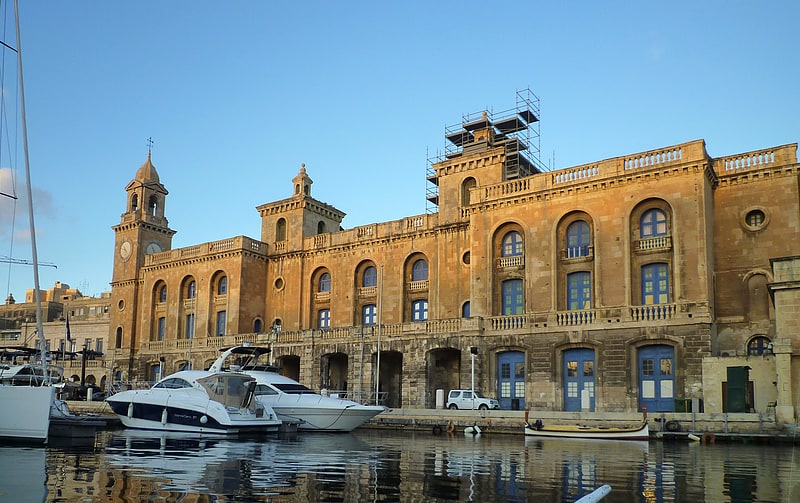
Museum in Birgu, Malta. The Malta Maritime Museum is a maritime museum in Birgu, Malta. It is housed in the former Royal Naval Bakery, which was built in the 1840s as the main bakery for the Mediterranean Fleet. The museum has a collection of over 20,000 artifacts, and it is the largest museum on the island.
The museum's aim is to illustrate Malta's maritime history, starting from prehistory to the present. The museum shows this within a Mediterranean and a global context.[45]
Address: Ex-Naval Bakery, Fgura
Palazzo Parisio, Naxxar
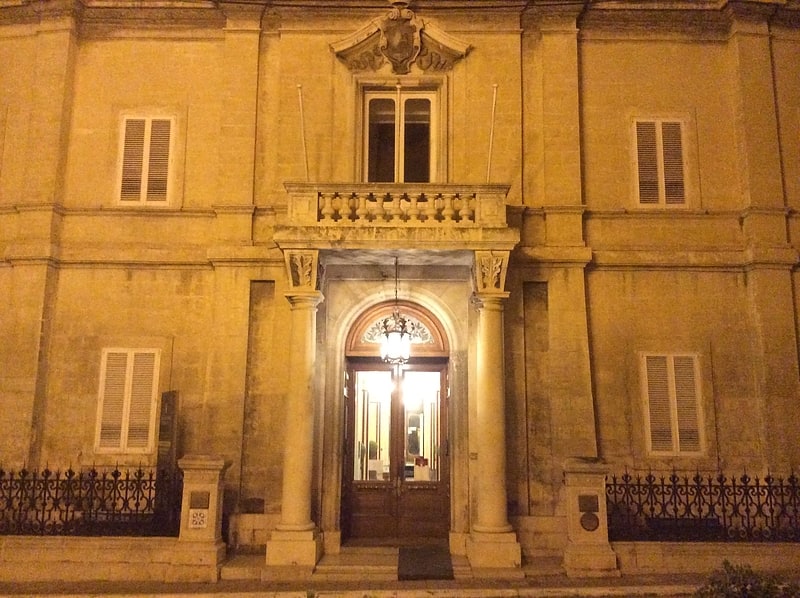
Palazzo in Naxxar, Malta. Palazzo Parisio, formerly known as Scicluna Palace, Palazzo Scicluna, and officially Palazzo Parisio and Gardens, is a 20th-century palace in Naxxar, Malta. On site was a hunting lodge built in 1733 by Paolo Parisio, and was used as a summer or permanent residence, barracks and a college, before being acquired by the Marquis Scicluna in 1898.
At one point the Marquis built the present palace between 1900 and 1907. Its architecture is composed of a modest Art Nouveau front and back façades and a Sicilian Baroque interior. Today, Palazzo Parisio and its surrounding gardens are in good condition and are open to the public.[46]
Address: 29, Victory Square, Naxxar
Ta' Pinu, Għasri

Catholic basilica and shrine with a view. The Basilica of the National Shrine of the Blessed Virgin of Ta' Pinu is a Roman Catholic minor basilica and national shrine located some 700 metres from the village of Għarb on the island of Gozo, the sister island of Malta.
Pope Pius XI granted a Pontifical decree of coronation, “Marianum exstat Sanctuarium” towards its venerated Marian image, the Blessed Virgin of Ta' Pinu on 24 May 1935. The Archbishop of Tarsus, Cardinal Alexis Lépicier signed and notarized the decree via the Sacred Congregation of Rites. The coronation of the image took place on 20 June 1935. The basilica is located in open countryside which allows visitors to enjoy beautiful views of the area and is of great national importance to Gozitans everywhere.[47]
Address: GRB 104, Gharb, Għasri
Ramla Left Battery, Xaghra
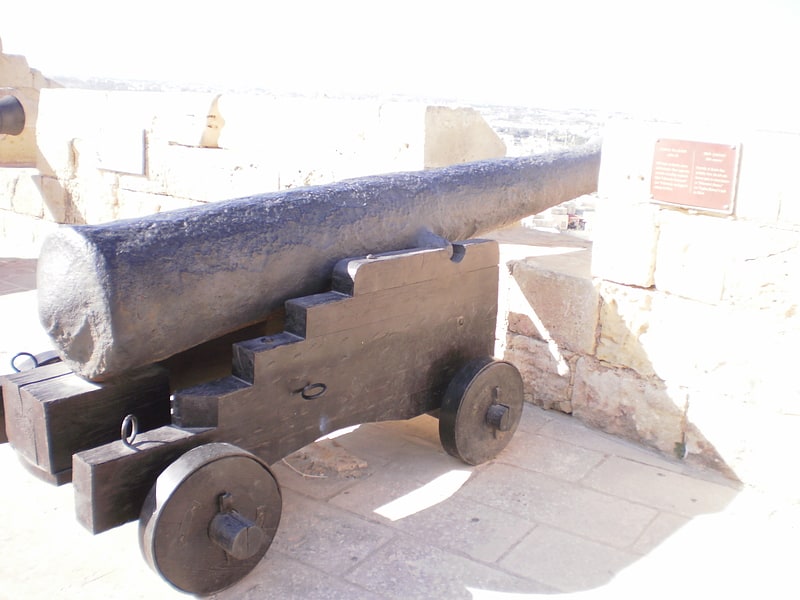
Ramla Left Battery, also known as Belancourt Battery or Xagħra Battery, was an artillery battery in Ramla Bay, limits of Xagħra on the island of Gozo, Malta. It was built by the Order of Saint John in 1715–1716 as one of a series of coastal fortifications around the Maltese Islands. The battery now lies in ruins.[48]
Address: Ramla l-Ħamra, Xaghra
Megalithic Temples of Malta, Xaghra
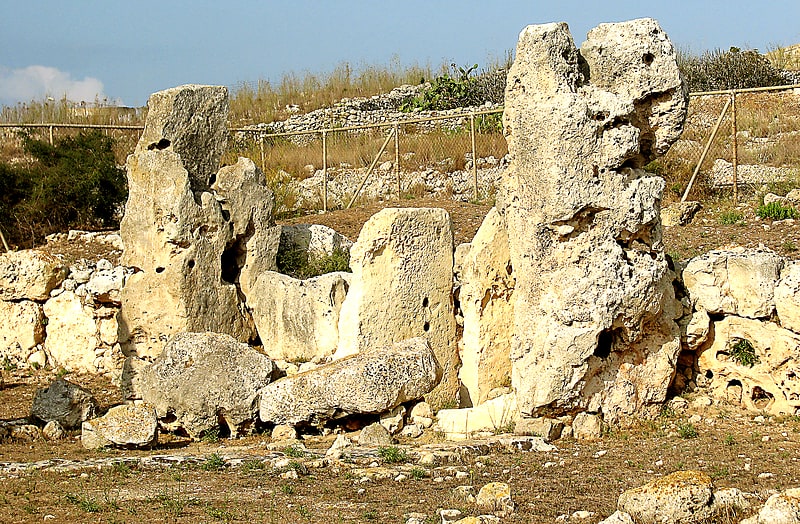
The Megalithic Temples of Malta are several prehistoric temples, some of which are UNESCO World Heritage Sites, built during three distinct periods approximately between 3600 BC and 2500 BC on the island country of Malta. They had been claimed as the oldest free-standing structures on Earth until the discovery of Göbekli Tepe. Archaeologists believe that these megalithic complexes are the result of local innovations in a process of cultural evolution. This led to the building of several temples of the Ġgantija phase, culminating in the large Tarxien temple complex, which remained in use until 2500 BC. After this date, the temple-building culture disappeared.
The Ġgantija temples were listed as a UNESCO World Heritage Site in 1980. In 1992, the UNESCO Committee further extended the existing listing to include five other megalithic temple sites. These are Ħaġar Qim (in Qrendi), Mnajdra (in Qrendi), Ta' Ħaġrat Temples (in Mġarr), Skorba Temples (in Żebbiegħ) and Tarxien Temples (in Tarxien). Nowadays, the sites are managed by Heritage Malta, while ownership of the surrounding lands varies from site to site. Apart from these, there are other megalithic temples in Malta which are not included in the UNESCO World Heritage list.[49]